Chapter 1
The Science of Reading
Scientists have learned a lot about the mental machinery that supports reading, and this research base inspires much of what I suggest you do throughout this book. So we need to get the basics of these scientific findings straight. I’ll introduce scientific findings about reading as they become relevant, but this chapter starts with three foundational principles, to which we’ll return again and again: (1) the sounds that letters make (not their shape) pose the real challenge as children learn to read print, (2) comprehending what we read depends mostly on our general knowledge about the topic, and (3) the key to motivation lies in getting kids to read even when they aren’t motivated to do so.
The Role of Sound in Reading
We think of reading as a silent activity—consider a hushed library—but sound in fact lies at its core. Print is mostly a code for sound. English uses some symbols that carry meaning directly; for example, “$” means dollars, “@” means at, and “:-)” means smiling. But “bag” is not a symbol for a paper sack. It’s three letters, each of which signifies a sound; together, the sounds signify a spoken word. English is not alone in using a sound-based writing system. All written languages have some number of symbols that carry meaning, but the workhorse of communication is a sound-based code.
Because writing uses visual symbols that signify sound, children who are learning to read must master three things. First, they must be able to distinguish letters. They must notice that “j” has a little tail that distinguishes it from “i.” (I’ll put letters and words in quotation marks when emphasizing what they look like on the page.) Second, they must learn the mapping between these visual symbols and their auditory counterparts—for example, that the letter “o” sometimes goes with one sound (as in the word TONE) but at other times goes with another sound (as in TON). (I’ll put letters and words in small capital letters when emphasizing their sound.)
There’s a third thing to be learned, and this is the least intuitive for us to appreciate; learning the mapping is not quite what you think. We think that the sound that goes with “t” is TEE, but that’s actually two sounds, a consonant and vowel sound. Children must be able to hear that TEE is two sounds; they must be able to hear individual speech sounds. To read, children must be able to know what T sounds like in isolation, because that’s the sound that goes with the letter “t.” That turns out to be especially hard for kids. Let’s start with the easier tasks and work our way to this tougher one.
The Visual Task in Learning to Read
Most kids find distinguishing one letter from another relatively easy. Sure, some letters are confusable because they have similar shapes (e.g., B, D, P, R) or are the mirror image of another letter (e.g., M/W, b/d). And beginning readers do indeed mix up letters that look similar, a phenomenon also observed in languages other than English. But we shouldn’t think this problem is worse than it is. The fortunate fact is that there aren’t that many letters to learn, so with some practice, kids get it (figure 1.1).

Figure 1.1. Confusable letters. Even experienced readers occasionally mistake one letter for another, a problem that can be made more likely by unusual fonts. Overall, however, distinguishing one letter from another is not the most common obstacle to learning to decode.
Source: © Jason Covich.
Learning Letter-to-Sound Mappings
Learning which sound goes with which letter seems rather obviously more challenging. As I noted, some letters do double-duty for sounds: “o” represents one sound in ton and another in tone. There are actually forty-four speech sounds used in English, so such doubling up is inevitable given that we have twenty-six letters. Worse yet, it’s not just that two sounds go with a single letter. Sometimes a single sound goes with either of two letters. For example “y” in the middle of words often sounds like “i” as in RHYME.
If you were creating an alphabet for English from scratch, it would be sensible to create forty-four letters and match each speech sound with one letter. But written English, alas, was not created from scratch. Our language is a mongrel: Germanic origins, heavily influenced by Scandinavian (Norman) and French invasions, and later by the adoption of Latinate and Greek words. That’s a problem because when we borrowed words, we frequently retained the spelling conventions of the original language.
In consequence, our letter-to-sound mapping is messy. That has caused misery among generations of school children, although it has provided fodder for light rhymers:
And yet things are not as bad as you might first think. English pronunciation looks more consistent when we take context into account. A well-known example of the anything-goes character of English spelling is the invented word “ghoti,” to be pronounced FISH—provided one pronounces GH as in the word “enough,” O as in the word “women,” and TI as in the word “motion.” Cute, but there’s a reason most would pronounce “ghoti” as GOATEE. The context of each letter matters. When “gh” appears at the start of a word, it’s pronounced as a hard g (e.g., GHASTLY, GHOST). In the middle of a word, it’s silent (e.g., DAUGHTER, TAUGHT). It’s pronounced as F only at the end of a word (LAUGH, TOUGH).
In fact, researchers have found that consonants at the start or end of single-syllable words are pronounced consistently about 90 percent of the time. Vowels in the middle of single-syllable words are pronounced consistently only 60 percent of the time, but when the vowel is an exception, the final consonant frequently helps to determine the pronunciation. So, for example, the vowel string “oo” is usually pronounced as in the word BOOT, but sometimes it’s pronounced as in the word BOOK. It turns out that “oo” has the latter pronunciation only when it’s followed by “k” or “r” (BOOK, BROOK, CROOK, SHOOK, POOR, DOOR, FLOOR).
There’s another reason to take heart about the seemingly crazy pronunciation of English words. Many words that break pronunciation rules are very common. “Gone,” “give,” are,” “were,” and “done” all break a rule: when a word ends with “e,” the vowel sound is long. (Hence, “give” should rhyme with HIVE.) Although these words break the rule, they appear so commonly they are good candidates simply to be memorized as exceptions.
So there’s no doubt that learning the mapping between letters and sounds is a challenge, but that’s not the aspect of learning to read that most often gives kids trouble. The sticking point is the hearing of the speech sounds. Let’s look at why that’s so hard.
Learning to Hear Speech Sounds
What sound do you associate with the letter “p”? You might think of it as PUH—that’s what parents often tell children—but that’s two sounds: the sound of the letter “p” and then a vowel sound after it, UH. The sound associated with the letter “p” is actually just a plosion of air—your vocal chords don’t vibrate at all. In fact, that’s the same plosion of air you make for the letter “b.” The only difference is that when you say BEE, your vocal chords vibrate to make the vowel sound at the same time you make the plosion of air, whereas when you say PEE, the vocal chords start to vibrate only about .04 seconds after the plosion. Yup. The difference between “p” and “b” hinges on this .04 second difference. So asking, “What sound does the letter ‘p’ make?” is nonsensical. The very definition of the sound depends on its relationship to neighboring sounds. It’s actually impossible to say P in isolation.
This problem—the difficulty of isolating speech sounds—is even worse than that. Individual speech sounds also vary depending on the surrounding context. Try this. Put your hand in front of your mouth and say POT. You feel the puff of air when you say the P. Now do the same thing saying SPOT. The puff is stronger for POT than SPOT. So we talk about “the sound the letter ‘p’ makes” as if there is one sound associated with “p,” but that’s an abstraction, an ideal.
We’re not done yet. Understanding where one word ends and another begins is important for reading—you need to know which sounds are supposed to clump together to form a word. But kids don’t hear individual words as well as adults do. In a standard test of this ability, you give the child a short sentence to keep in mind—say, “I like yellow bananas.” You give him a small basket of blocks and ask him to arrange a line of them, one block for each word in the sentence. There’s no guarantee that the child will pick four blocks for the sentence. It might be three, or five, or seven. He is just not sure where words begin and end (figure 1.2).
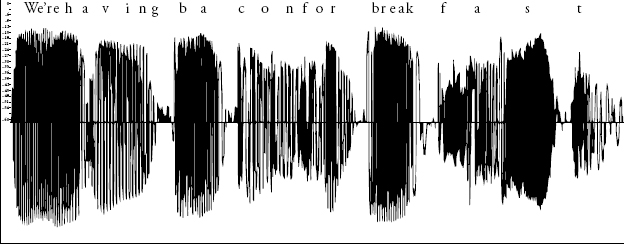
Figure 1.2. Visual representation of a sentence. The author is saying, “We’re having bacon for breakfast.” Time moves left to right, and the vertical axis shows sound intensity. When people speak, there are not clean breaks between each word, which is probably why children have trouble knowing where words begin and end.
Source: © Daniel Willingham.
Children’s ability to hear individual speech sounds can be tested in different ways. They might be asked to name the sound at the beginning of a word. They might be asked if two words begin with the same sound or end with the same sound. In more challenging tasks, they might be asked to change a word by adding, removing, or manipulating sounds, for example, “If I took the word TOP and added a SSSS at the beginning, what word would it make?”
If reading is a code between written symbols and speech sounds, it’s going to be hard to learn the code if you can’t hear those sounds. Lots of research indicates that this reasonable supposition is right. Children who have trouble learning to read often have difficulty hearing individual speech sounds. At the other end of the spectrum, children who more or less teach themselves to read turn out to hear them easily. This relationship between the ability to hear speech sounds and reading is not unique to learning to read English—you see it across languages.
So we have our first clue about how we can help kids become good readers: help them with this auditory challenge.
The Role of Knowledge in Comprehension
So far, I have discussed decoding and reading as though they were synonyms, but obviously there’s more to reading than sounding out words. A child might read aloud, “the farmer in the dell,” and perhaps recognize the phrase from the song, but if he doesn’t know that a dell is a small valley, he’s not fully understanding the meaning of what he’s read. It’s equally obvious that in order to understand, a reader must use syntactic rules that relate words to one another. Syntactic rules determine the difference in meaning between, “Dan wished he had sung better,” and, “He wished Dan had sung better”—same words, slightly different order, quite different meanings.
We’ll skip discussing the mental processes that allow us to understand the meaning of individual words like “farmer” and “in,” as well as the mental processes that assign syntactic roles to individual words so that they are connected into a sentence. Fascinating as these processes are, they usually pose few problems to young readers, or when they do, it’s for easily appreciated reasons. For example, a reader won’t understand a text that uses unfamiliar vocabulary (“This class needs realia”) or syntax so complex it’s hard to unravel (e.g. “The dog that the man whom the cat saw kicked yelped”). When the former happens, you look the word up. When the latter happens, you complain of poor writing.
Building Meaning across Sentences
Processes of reading comprehension that go beyond the individual word and sentence are less obvious. There must be some way that we can make meaning across sentences—something akin to the way syntax connects meaning across words. For example, consider these two sentences: “The octogenarian scientist approached the podium to collect his Nobel prize, head down, embarrassed by the applause. He chuckled softly to himself.” To understand this brief text, we must recognize that “he” in the second sentence and “the octogenarian scientist” from the first sentence refer to the same person. We must also understand that the chuckling in the second sentence is directly related to the information provided in the first sentence; the information explains why he was chuckling. How do we connect ideas from the sentence we’re currently reading to something we read earlier?
The answer rests on a distinction between given and new information. Given information is stuff that you have already been told in the text. New information is stuff you haven’t. Most writing alternates between the two: you are reminded of something you were already told, and then you’re told something new. Then something old again, then something new.
For example, suppose you read, “Some beer is in the car trunk. The beer is warm.” In the second sentence, the reference to “the beer” is the given information. The given information directs your attention to an idea from an earlier sentence. Ah, you think, we’re talking about the beer again. Once you’ve focused on that idea, the new information in the sentence provides something to add, and you connect it to the given information. So you will connect “warm” in the second sentence to “the beer” from the first sentence (figure 1.3).
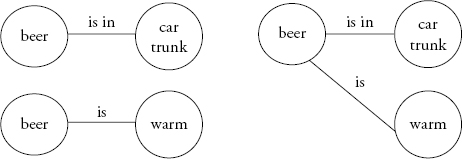
Figure 1.3. How sentences are connected. At left is a cartoon version of the formal way that a psychologist would diagram your understanding of the two sentences in the text. When you read “the beer is warm,” you look for some overlap between this sentence and the ideas in the one you had already read. When you find the overlap (the reference to “beer”), that tells you it’s a way to connect the two sentences. The connection is shown at right.
Source: © Daniel Willingham.
This given-new principle is powerful enough that it’s jarring to read prose that violates it. For example, suppose you read: “Some beer is in the car trunk. The beer is warm. The beer is not cold.” The third sentence has given information (the beer) that doesn’t add anything new; if you know it’s warm, obviously it’s not cold. That’s so odd that you might struggle to find a way to interpret the third sentence so that it does tell you something new. (Perhaps the repetition is meant to signal that the beer was supposed to be cold.) Likewise, it sounds very strange to read a sentence that doesn’t mention any given information, as in this example: “Some beer is in the car trunk. Deciduous trees lose their leaves in the fall.” You have no way to connect the second sentence to what you’ve read so far. That’s what makes it a non sequitur.
This type of connection is important but pretty limited. I tell you something about beer; then I tell you another fact about the beer. That’s fine as far as it goes; sometimes I want to tell you several things about beer (or whatever else), so the beer is the given, and I keep telling you new things about it.
More common, however, are causal connections. For example, consider these two sentences: “Trisha spilled her coffee. Dan jumped from his chair to get a rag.” I’m sure the second sentence did not feel like a non sequitur to you; you easily connected them. But wait a minute. If connections happen when there is given and new information, where is the “given” information in the second sentence? Where did I repeat something I already told you?
The given information is not really in the text. It’s in your head. You inferred it. You know that spilled coffee makes a mess. You know that when a mess is made, people usually clean it, and often do so immediately. You know that rags are often used to clean messes.
Now the writer could have included all of this information in the text. He could have written, “Trisha spilled her coffee. The coffee made a mess on the floor. Dan wanted to clean the mess. Dan had rags in the kitchen that he used for cleaning. Dan jumped from his chair to get a rag.” In this version, the given information is made explicit, but the reason that writers (and speakers) omit information is plain: if you didn’t omit stuff that the reader knows anyway, simple communication would be terribly boring.
The author can’t include every last bit of information that’s needed to make her writing comprehensible lest she tell the reader things he already knows. But then again, every time she elects to leave out some information, she’s gambling. She’s assuming that the reader has the omitted information in memory. What if the writer is wrong? Then the reader will not be able to connect the sentences and comprehension will fail. That’s what happens when you start to read an article on some unfamiliar technical subject: it’s written for an audience with a lot of knowledge you lack.
But comprehension doesn’t always fail. Sometimes you can deduce the missing information from the context. Reading researcher Walter Kintsch offered this example: “Connors used Kevlar sails because he expected little wind.” All I know about Kevlar is that it’s some sort of fabric. I sure didn’t know that it is used for sails, but that’s easy to infer from the context, right? So what’s the problem with reading this sentence? (See figure 1.4.) No problem. In fact, that’s one of the great pleasures of reading. You learn new things, for example, that sails can be made of Kevlar. But figuring things out in this way amounts to problem solving and solving problems takes time and mental effort. It’s not just that you have to think about what “Kevlar” might mean; it’s also that figuring that out interrupts the flow of the text in which you find it. You may lose the thread of the argument or story. A bit of this sort of problem solving is satisfying, even fun. Too much of it makes reading slow and difficult.
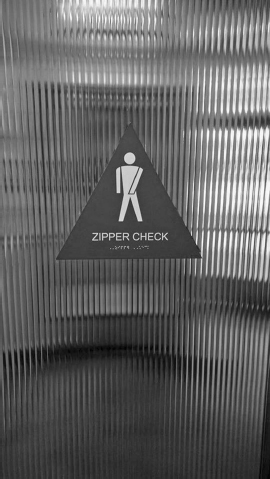
Figure 1.4. Context resolves ambiguity. This sign assumes a certain amount of background knowledge that is left unstated. For what are you to check your zipper? Should I check all zippers on my person, even the zipper on my briefcase? The ambiguity is resolved by the context: this sign appeared on the exit door of a men’s bathroom.
Source: © Daniel Willingham.
Just how much unknown stuff can a text have in it before a reader will declare, “Mental overload!” and call it quits? That surely varies depending on the reader’s attitude toward reading and motivation to understand that particular text. Still, studies have measured readers’ tolerance of unfamiliar vocabulary and have estimated that readers need to know about 98 percent of the words for comfortable comprehension. That may sound high, but bear in mind that the paragraph you’re reading now has about seventy-five unique words. So 98 percent familiarity means that this and every other paragraph like it would have one or two words you don’t know. That’s a lot.
What’s a “Good Reader”?
The discussion to this point implies that people who are good readers are people who know a lot. A lot of what? What kind of knowledge makes you a good reader? That depends on what you want to read. Authors omit information based on their guess as to what their audience already knows. A writer for the Journal of the Lepidopterist’s Society will omit a whole lot of information about butterflies, figuring that her audience already knows it.
Most parents want their children to be solid general readers. They aren’t worried about their kids reading professional journals for butterfly collectors, but they expect their kids to be able to read the New York Times, National Geographic, or other materials written for the thoughtful layperson. A writer for the New York Times will not assume deep knowledge about postage stamps, or African geography, or Elizabethan playwrights—but she will assume some knowledge about each. To be a good general reader, your child needs knowledge of the world that’s a million miles wide and an inch deep—wide enough to recognize the titles The Jew of Malta and The Merchant of Venice, for example, but not that the former may have inspired the latter. Enough to know that rare stamps can be very valuable, but not the going price of the rare Inverted Jenny stamp of 1918.
If being a “good reader” actually means “knowing a little bit about a lot of stuff,” then reading tests don’t work quite the way most people think they do. Reading tests purport to measure a student’s ability to read, and “ability to read” sounds like a general skill. Once I know your ability to read, I ought to be able (roughly) to predict your comprehension of any text I hand you. But I’ve just said that reading comprehension depends heavily on how much you happen to know about the topic of the text, because that determines your ability to make up for the information the writer felt free to omit. Perhaps, then, reading comprehension tests are really knowledge tests in disguise.
There is reason to think that’s true. In one study, researchers measured the reading ability of eleventh graders with a standard reading test and also administered tests of what they called “cultural literacy”—students’ knowledge of mainstream culture. There were tests of the names of artists, entertainers, military leaders, musicians, philosophers, and scientists, as well as separate tests of factual knowledge of science, history, and literature. The researchers found robust correlations between scores on the reading test and scores on the various cultural literacy tests—correlations between 0.55 and 0.90.a
So Where Do You Get Broad Knowledge?
If knowledge is so important to reading, where do you get it? Many sources, of course: conversations, television, movies, the Internet. But research has shown that people with broad general knowledge—the type of knowledge that makes good general readers—gained most of that knowledge by reading. (This work was conducted before access to the Internet was widespread, but in Chapter 9, I discuss other research indicating that kids aren’t likely to gain much knowledge from most of their online activities.)
Here’s how researchers tested this hypothesis. First, they needed a measure of how much people had read when they were growing up. They could have asked, “Were you a reader as a kid?” but that’s a pretty subjective judgment. Researchers figured that readers would be more likely to recognize the names of well-known authors, books, and magazines, so they gave people a list of author names and titles; some were real, and some they had made up to sound plausible. (Exhibit 1.1 shows a sample of magazine titles.) Subjects were asked to identify the real ones.
Their prediction was that people who did well on this test must have done a lot of reading, and so scores on the test would be positively correlated with knowing a lot of stuff. To get a measure of “knowing a lot of stuff,” they used a battery of tests measuring common knowledge of science, history, the arts, and so on.
The results did show a substantial correlation; people who recognized a lot of author and magazine names had very broad cultural knowledge. But of course that relationship could be due to something else—it’s correlation, not causation. The most obvious candidate would be intelligence. Maybe smart people like to read as kids and smart people know a lot. So the researchers used another battery of measures to get at intelligence—metrics like high school grade point average and performance on a standard intelligence test. And indeed, intelligence was related to how much college students knew. Related, but not the whole story. Reading volume was still a big contributor. In other words, smart people (high IQ, good grades) who never read much as kids didn’t have a lot of general knowledge as adults. And not-so-smart people (low IQ, poor grades) who read a lot as kids did have a lot of general knowledge.
So we’ve come full circle. We began by examining how sentences are connected to build larger meanings and quickly came to the idea that the reader must bring knowledge to this process to make up for the information that the writer omitted. We noted that sometimes the reader who lacks this knowledge can use the rest of the text and some reasoning power to make up for this missing knowledge; that’s what happened when I learned that sails can be made of Kevlar. Finally, we saw that this process is not only possible, but seems to be very important to reading, because adults with broad background knowledge (which helps them to be good readers) got that background knowledge by reading. You need knowledge to read, and reading gives you knowledge.
So now we have our second clue about how to help children become good readers. They need a broad foundation of knowledge of words and the world.
Motivation
A boy might be motivated to read Looking for Alaska to impress a girl or because it was assigned in school. It seems self-evident that these are not the sort of motivators we’re after because they’re temporary. We want our kids to read because they have a positive attitude toward reading, because they find the activity itself rewarding. Unfortunately, although kids like reading (both at home and at school) in the early grades, their opinions become more and more negative as they get older. By high school, the average kid is at best indifferent to reading. What can be done to change that?
Attitudes toward Reading
Before thinking about how to change reading mind-sets, we need to know what type of attitude we’re dealing with. Some attitudes are the product of a logical analysis, at least, as logical as we can make them. I recently bought a dishwasher, and my attitudes toward dishwasher brands (I like Kenmore, I don’t like Whirlpool, and I think Bosch is overrated) are a product of research on repair records, efficiency, and so on. My opinions are pretty cold and pretty rational.
We like to think that most of our attitudes are rational, that our opinions are the product of fact gathering and logical analysis. But we have attitudes about things where analysis is impossible, or at least much less likely. Why do you prefer Coke to Pepsi, or Old Spice to Brut? No one says, “I’ve looked into the matter, and research shows that Old Spice makes a man more attractive to women and tends to make other men submissive.” You use Old Spice because you like the way it smells, and, perhaps equally important, you like the way it makes you feel. These are emotional attitudes. Emotions also play heavily in attitudes to things that are intertwined with our values—issues like abortion or capital punishment. You could bring logical analysis to bear on such issues, and people like to think that they do. But the logical arguments are mostly post hoc and marshaled to justify the emotionally driven opinion.
It’s a good bet—although there’s limited research on this question—that a child’s reading attitude is mostly emotional. It’s not a reasoned judgment of its value to her future career prospects. It’s based on whether reading seems rewarding, excites her, interests her. So where do emotional attitudes come from?
The Origins of Emotional Attitudes
Here’s Oprah Winfrey on reading: “Books were my pass to personal freedom. I learned to read at age three, and discovered there was a whole world to conquer that went beyond our farm in Mississippi.” One source—probably the primary source—of positive reading attitudes is positive reading experiences. This phenomenon is no more complicated than understanding why someone has a positive attitude toward eggplant: you taste it and like it. Oprah tasted the mental journeys reading affords and loved them (figure 1.5).
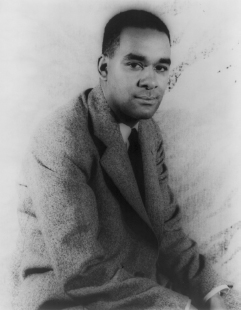
Figure 1.5. Twentieth-century writer Richard Wright. In his autobiography, Wright describes his first encounter with a fictional story. A young woman—a teacher who boarded at Wright’s grandmother’s house—learned that he was unfamiliar with children’s stories and so told him a pirate’s tale. He was bewitched: “My sense of life deepened, and the feel of things was different, somehow. The sensations the story aroused in me were never to leave me.”
Source: Carl Van Vechten photograph, retrieved from http://www.loc.gov/pictures/item/2004663766/
We can elaborate a bit on this obvious relationship. Kids who like to read also tend to be strong readers as measured by standard reading tests. Again, this is not terribly surprising: we usually like what we’re good at, and vice versa. This situation yields a positive feedback loop (figure 1.6).
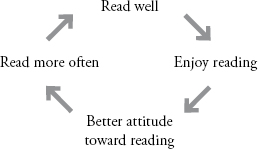
Figure 1.6. Reading virtuous cycle.
Source: © Daniel Willingham.
If you’re a good reader, you’re more likely to enjoy a story because reading it doesn’t seem like work. That enjoyment means that you have a better attitude toward reading; that is, you believe that reading is a pleasurable, valuable thing to do. A better attitude means you read more often, and more reading makes you even better at reading: your decoding gets better and better, and all that reading you’re doing adds to your background knowledge. We would also predict the inverse to be true: if reading is difficult, you won’t enjoy it; you’ll have a negative attitude toward the activity, and you’ll avoid it when possible, meaning that you’ll fall still further behind your peers. This cycle has been called “the Matthew effect” from the biblical verse, “For whosoever hath, to him shall be given, and he shall have more abundance; but whosoever hath not, from him shall be taken away even that he hath” (Matthew, 25:29). More succinctly, the rich get richer and the poor get poorer.
Reading Self-Concept
As you probably know, Twitter is a website that allows users to broadcast very short messages. Users are also invited to compose a brief profile—a self-description that anyone can view. The profile is limited to 160 characters, so users must be concise; to give you a sense of the need for brevity, the sentence you’re now reading is forty-nine characters too long. If you don’t have a Twitter account, consider for a moment how you might describe yourself in 160 characters. For economy, many people write a series of self-descriptive phrases (figure 1.7). Twitter profiles are not a bad way of thinking about our self-concept. It’s a cluster of generalizations about how we tend to act (introvert, activist) and roles we fill (professor, father).
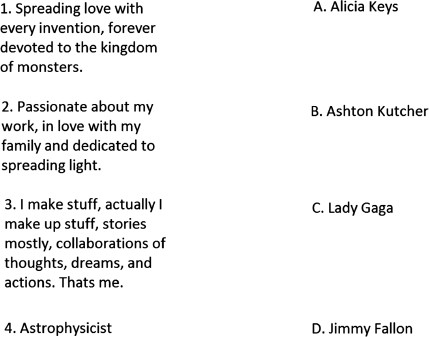
Figure 1.7. Twitter bios as statements of self-concept. When we’re forced to be concise, our self-descriptions often refer to roles we play and personality descriptions. See if you can match the Twitter biography (left) with the writer (right).
Source: Twitter profile text obtained from Twitter.com, September 8, 2014.
Here we’re interested in one narrow aspect of the self: how you see yourself when it comes to reading. Your reading self-concept is probably related to your attitude toward reading, but the two are not synonymous. You might think that reading is useful (and so your attitude is positive) and also see yourself as quite competent as a reader. But you don’t see it as an important part of who you are. For that reason, I think that reading self-concept is more important than reading attitudes. The purpose of this book is not to help you raise a child who has a positive attitude toward reading but never reads.
If “reader” is part of your self-concept, it will occur to you as a viable activity more often. “What will I do on that two-hour train trip? I could bring my iPod. Oh, I should bring a book too.” And of course, the more you read, the more “reader” becomes cemented as part of your self-concept. What I do and what I think of myself reinforce one another (figure 1.8). Conversely, children who do not have “reader” as part of their self-concept are not likely to think of it as an option. They may be neutral or even mildly positive in their attitudes toward reading but do not see it as “one of the things I do.” Analogously, I don’t make a conscious decision not to attend renaissance fairs. It’s not that I don’t like them. It never even occurs to me to think about whether I might enjoy going (figure 1.8).
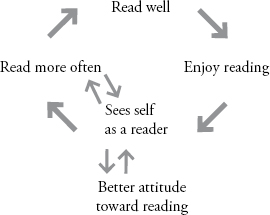
Figure 1.8. Reading virtuous cycle with self-concept added. Reading self-concept is both built by and a contributor to positive reading attitudes and the act of reading.
Source: © Daniel Willingham.
Why does one four-year-old have a developing sense of herself as a reader and another not? It seems obvious that I would think of myself as a reader if I read a lot. That’s true, and it’s especially true if I perceive that I read more than other people do; it’s something that separates me from my peers. Very young children don’t engage in such extensive comparisons; that’s for older kids. Still, you want your child to read at an early age (even if “reading” means looking at pictures) in order to build a reading self-concept.
Looking over this section on reading motivation, it may seem that we’ve made little progress. I identified two important factors: positive reading attitudes and a sense of oneself as a reader. But the genesis of each is predicated on your child’s doing some reading, and that’s the problem we’re trying to solve. If your child were doing a lot of reading, we wouldn’t be concerned about his attitude or self-concept. That conundrum harkens back to our discussion of reading comprehension in which I said that the way to improve reading comprehension is to improve the child’s background knowledge, and the way to improve background knowledge is to read. So the secret to raising kids who read is to have reading kids?
In part, yes. And maybe it shouldn’t be surprising that reading is the best way to support good decoding, comprehension, and motivation. Still, we need a way out of that revolving door, and in the chapters that follow I’ll suggest two tactics. First, we examine ways other than reading that support decoding, comprehension, and motivation. Second, we look at ways to get your child reading even if his attitudes are not that positive and his reading self-concept is weak. The hope is that kick-starting reading will generate a positive feedback cycle.
Let’s get started.
Answers to exhibit 1.1: The actual titles are: Better Homes and Gardens, Car and Driver, New Republic, Scientific American, and Town and Country.
Notes
“a phenomenon also observed in languages other than English”: Treiman and Kessler (2003); Treiman, Kessler, and Pollo (2006); Treiman, Levin, and Kessler (2012).
“light rhymers”: Vaughn (1902).
“Many words that break pronunciation rules are very common.”: Ziegler, Stone, and Jacobs (1997).
“just not sure where words begin and end”: Holden and MacGinitie (1972).
“Children who have trouble learning to read often have difficulty hearing individual speech sounds.”: Melby-Lervåg, Lyster, and Hulme (2012).
“children who more or less teach themselves to read turn out to hear them easily”: Backman (1983).
“you see it across languages”: Anthony and Francis (2005); Hu and Catts (1998).
“Kintsch offered this example”: Kintsch (2012).
“Too much of it makes reading slow and difficult.”: Foertsch and Gernsbacher (1994).
“readers need to know about 98 percent of the words”: Carver (1994); Schmitt, Jiang, and Grabe (2011).
“The researchers found robust correlations between scores on the reading test and scores on the various cultural literacy tests.”: Cunningham and Stanovich (1991, 1997); Stanovich and Cunningham (1993); Stanovich, Cunningham, and West (1995); see also Anderson, Wilson, and Fielding (1988).
“their opinions become more and more negative as they get older”: Eccles, Wigfield, Harold, Blumenfeld, and Url (1993); Jacobs, Lanza, Osgood, Eccles, and Wigfield (2002); Kush and Watkins (1996); McKenna, Conradi, and Meyer (2012); McKenna, Kear, and Ellsworth (1995).
“we have attitudes about things where analysis is impossible”: For a review of the three types of attitudes, see Aronson, Wilson, and Akert (2012).
“the logical arguments are mostly post hoc and marshaled to justify the emotional opinion”: For a review of this literature, see Haidt (2012).
“This situation yields a positive feedback loop.”: Mol and Bus (2011).
“your decoding gets better and better, and all that reading you’re doing adds to your background knowledge”: The best evidence for this assertion comes from studies that employ structural equation models (e.g., Clark & DeZoysa, 2011). For data that examine the relationship across countries, see Lee (2014).
“The Matthew effect”: Stanovich (1986).
“the rich get richer and the poor get poorer”: Morgan and Fuchs (2007).
“if ‘reader’ is part of your self-concept”: For more on reading self-identity, see Hall (2012).
“What I do and what I think of myself reinforce one another”: Retelsdorf, Köller, and Möller (2014).
